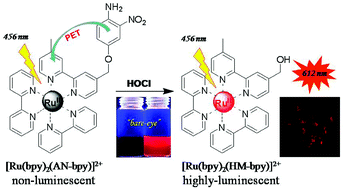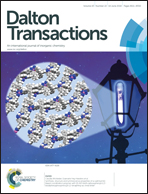Development of a functional ruthenium(ii) complex for probing hypochlorous acid in living cells†
Abstract
A functional ruthenium(II) complex, [Ru(bpy)2(AN-bpy)](PF6)2 (bpy: 2,2′-bipyridine, AN-bpy: 4-methyl-4′-(4-amino-3-nitro-phenoxy-methylene)-2,2′-bipyridine), has been designed and synthesized as a turn-on luminescent probe for the imaging of hypochlorous acid (HOCl) in living cells. Due to the intramolecular photoinduced electron transfer (PET), the ruthenium(II) complex itself is almost non-luminescent. However, it can specifically and rapidly react with HOCl in aqueous media to afford a highly luminescent derivative, [Ru(bpy)2(HM-bpy)](PF6)2 (HM-bpy: 4-hydroxymethyl-4′-methyl-2,2′-bipyridine), accompanied by a 110-fold luminescence enhancement. Taking advantage of high specificity and sensitivity, and excellent photophysical properties of the ruthenium(II) complex probe, [Ru(bpy)2(AN-bpy)](PF6)2 was successfully applied to the luminescence imaging of the exogenous HOCl in living HeLa cells and the endogenous HOCl in porcine neutrophils. The results corroborate that indeed [Ru(bpy)2(AN-bpy)](PF6)2 is a useful luminescent probe for the monitoring of HOCl in biological systems.


 Please wait while we load your content...
Please wait while we load your content...